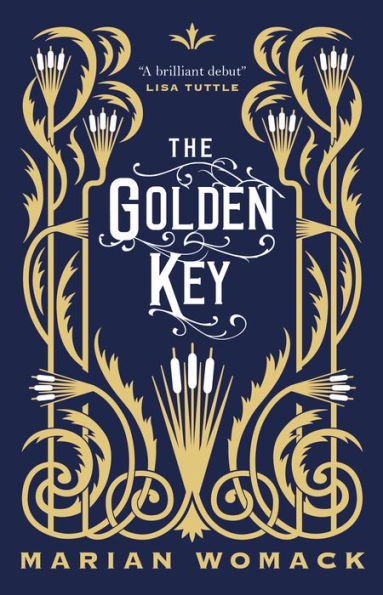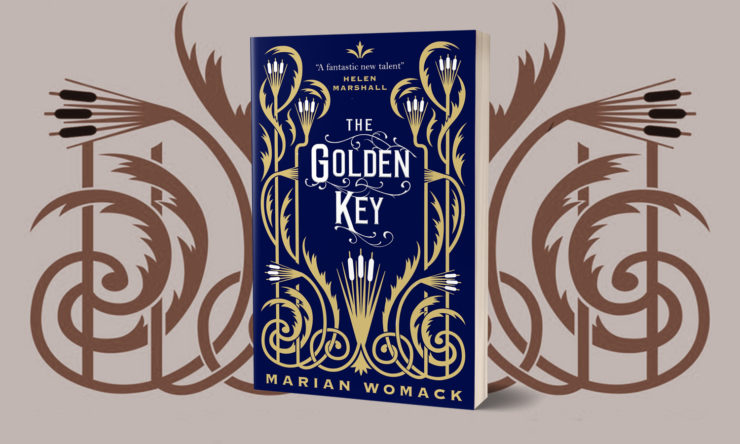Marian Womack’s fiction finds the middle ground between haunting landscapes and the surreal. She’s edited an anthology in collaboration with Gary Budden, whose work occupies a subgenre known as “landscape punk.” And a review of her 2018 collection Lost Objects in Weird Fiction Review cited the story “Kingfisher,” and highlighted “a blurred boundary between an initially recognizable world and a later turn toward something much weirder.”
While much of Womack’s work to date has been set around the present or in a possible future, her new novel The Golden Key opts for a very different locale: England in 1901.
The milieu among Womack’s culturally astute, intellectually rigorous cast of characters is one where spiritualism is in its heyday. The narrative is largely split between two characters: Samuel Moncrieff and Helena Walton-Cisneros. Moncreiff is a troubled young man, struggling to come to terms with a harrowing event that took place before the novel begins. Helena is a medium, but also an investigator into bizarre crimes and unexplained events—and the ways in which she comes into focus as a detective over the course of the novel are one of this book’s greatest joys.
Buy the Book


The Golden Key
The Golden Key takes a little time to come into focus. Early on, we’re treated to a sense of a society in flux: Queen Victoria has died, and nominal experts in the supernatural are holding events across London. Throughout these early pages, it’s not entirely clear whether Womack is establishing the groundwork for a realistic novel set against a background of spiritualism, or something that ventures more headlong into the supernatural. The mention of a sinister figure named Bévcar, who leads a group that venerates him in a cultlike manner, suggests something brewing just below the surface—but whether it’s uncanny or a more mundane version of the sinister remains to be seen.
Helena is eventually summoned north by the aristocratic Lady Matthews, to take on a case involving a disappearance—three of them, in fact—which took place twenty years earlier. The vanished people in question were three sisters; the timing of their disappearance also lines up, more or less, with Samuel’s birth. How those two events are connected—or even if they are—remains to be seen. But from the moment when Helena begins her investigation, there’s a sense that something is deeply wrong in this corner of the world.
“For the light had changed its quality somehow, it had become denser, less fluid; more leaden with white, less transparent. The best comparison she could think of was doing a watercolor sketch, that moment when the sky is worked and, by mistake, you dip your brush in the white paint and add it to the light and fluid water-and-blue mixture. It suddenly acquires density, becomes opaque, acquires weight.”
The light isn’t the only odd characteristic of the marshes: there are also odd substances floating in mid-air, and at least some of the locals appear to bear psychological scars from encounters with something bizarre. And there’s a ruined manor, infused with fungus, that seems to have an otherworldly and sinister atmosphere.
Once Helena’s investigation is underway, the novel’s momentum takes on more velocity. It’s not hard to see why: she’s underestimated by those she meets, and there’s more than a little deductive reasoning in her methodology. And having a character who’s able to navigate numerous social strata, never quite fitting in with any of them, offers a dash of the traditional detective story in a novel that blends seemingly disparate elements towards a compelling end.
In the end, the solution to this bizarre mystery comes to light; besides the spiritualists and cult leaders on this novel’s fringes, an author of children’s books—whose work gives this novel its title—also factors into the solution. For that reason, this is ultimately a very literary kind of historical mystery, reminiscent in places of works like Jeanette Ng’s Under the Pendulum Sky and Kim Newman’s Anno Dracula. The conclusion of the mystery, and the revelation of Samuel’s connection to it all, make for a haunting denouement. But it’s in keeping with Womack’s past work that the most resonant moments in this novel are those where the landscape becomes a character, and arguably the most sinister one to be found within these pages.
The Golden Key is available from Titan Books.
 Tobias Carroll is the managing editor of Vol.1 Brooklyn. He is the author of the short story collection Transitory (Civil Coping Mechanisms) and the novel Reel (Rare Bird Books).
Tobias Carroll is the managing editor of Vol.1 Brooklyn. He is the author of the short story collection Transitory (Civil Coping Mechanisms) and the novel Reel (Rare Bird Books).










